
ACTION: C.4:
Ecologically sustainable high level grazing on sodic lakes and their catchment areas
The aim of the action is the improvement of sodic lake’s characteristics of the site. In the beginning this could have been ensured with a transition of a grazing lake.
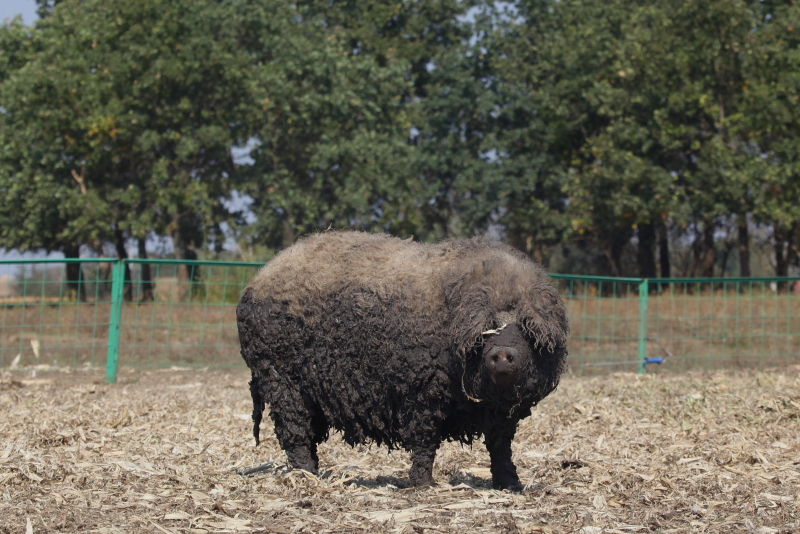
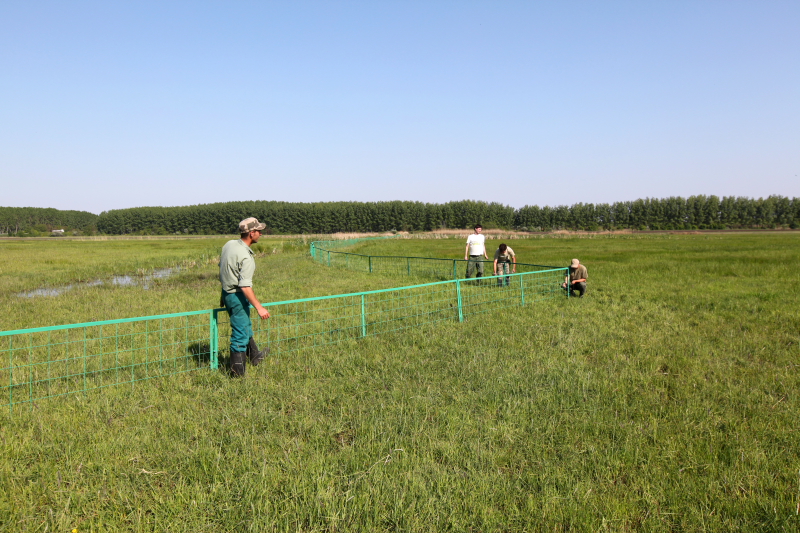
Photos: The ecologically sustainable high level of grazing is a very important task in the resurrection of a ’resting’ sodic lake. Top: Nagy-szik farm, the centre of association for keeping livestock; Bottom left: Building electric fence on Kerek-fenék with the help of volunteers; Bottom right: Mangalica pig in electric fence (Photos: János Oláh)
In 2009: In March our electric fence systems were set therefore the move of our animals became easier on the ecologically sustainable high level grazing sites. In spring the mobile electric fence was in Kerek-fenék and in autumn it could be found on Nagy-szik. In April a farm was purchased on Nagy-szik (1259m2) which became the centre of the association for keeping livestock. Obtaining the ecologically sustainable high level grazing we purchased more livestock and we also organized other owners with animals to the project site. According to data from 2008, it can be seen on the table below that the number of livestock grazing on one hectare was increasing significantly on the project site (before the start of our project).
Type of Livestock |
Livestock to be purchased during the project period(ind.) |
Livestock purchased in 2009 (ind.) |
Other livestock brought to the project site in 2009 |
All the grazing livestock on the project site in 2008 (ind.) |
All the grazing livestock on the project site in 2009 (ind.) |
Cattle |
100 |
38 |
337 |
695 |
1070 |
Horse |
10 |
2 |
14 |
0 |
16 |
Donkey |
10 |
5 |
0 |
0 |
5 |
Pig |
60 |
34 |
61 |
0 |
95 |
Sheep |
300 |
108 |
0 |
2150 |
1864 |
Goose |
800 |
200 |
0 |
0 |
200 |
In 2010: It was an exceptionally wet year in the Hortobágy area and the entire region including the project area experienced grazing difficulties and shortage of food. We did not increase the number of livestock as the available grazing habitat was very limited. Donkeys proved to be very good in maintaining the bare sodic patches and also can be used for grazing in wet and extreme conditions far better than sheep. We bought 11 more donkeys. We also had to purchase a bull Hungarian Grey Cattle and according to the plans 200 more geese were bought as well. All livestock type was suffering because of the wet conditions and the mortality was high especially amongst the young ones. Although the number of livestock did not increase significantly in the project area in 2010 but the ecologically high level of grazing was concentrated even more so the extension of the bare sodic patches increased (more here).
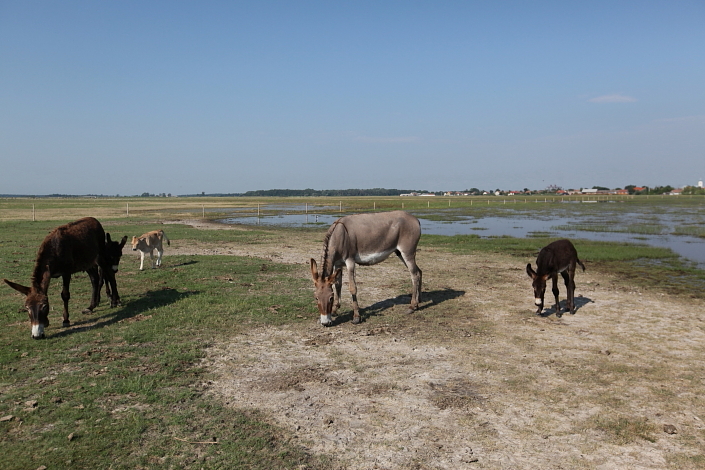
Picture: Donkeys were effective in maintaining the bare sodic patches (Photo: János Oláh)
In the Spring 2010 FNB (A Balmazújvárosi Nagyszikért Alapítvány) commissioned an expert to prepare a study which includes both theoretical and practical items how to encourage local people for animal keeping.
Livestock breeds |
Livestock to be purchased during the project (ind.) |
Livestock purchased in 2010 (ind.) |
Total number of grazing livestock at the project site in 2010 (ind.) |
Cattle |
100 |
1 |
804 |
Horse |
10 |
0 |
16 |
Donkey |
10 |
11 |
18 |
Mangalica pig |
60 |
0 |
75 |
Racka sheep |
300 |
22 |
2180 |
Goose |
800 |
200 |
300 |

Picture: Grazing Racka Sheep at the project site (Photo: János Oláh)
In 2011: The intended target of the action has been 100% achieved as the ecologically sustainable high level of grazing foreseen in the project proposal has already been achieved by November 2011. The extension of halophyta plant associations, the extension of bare sodic patches and the increased number of the characteristic breeding and migrating bird species indicate the positive change in the ecological factors of formerly destroyed sodic pan. The water chemistry characteristics also reached the sodic lake level. The project area has already reached a higher nature conservation value by November 2011 compared to the degraded state at the beginning of the project.
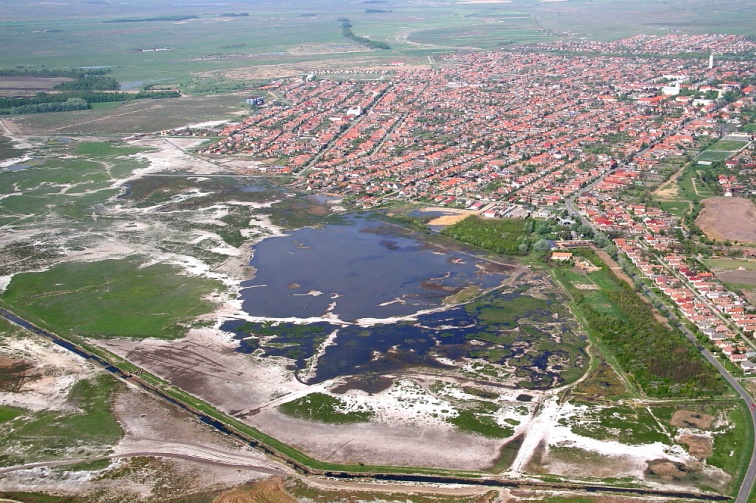
Picture: Aerial image of the project site in April 2011 where bare sodic patches visible around the lake which is partly the result of the ecologically sustainable high level of grazing (Photo: János Oláh).
The racka sheep donation scheme has also been launched in 2011 by the associated beneficiary FNB. A total of 110 racka sheep was purchased under the project and leased to local people (10 families). The contracts also allow the farmers to keep the increase but the sheep must be grazed at the project site. This way we can stimulate people to start or continue long-term traditional grazing on the project site. Four of these farmers were also interviewed for the forthcoming 20th Anniversary LIFE publication.
Livestock breeds |
Livestock to be purchased during the project (ind.) |
Livestock purchased in 2011 (ind.) |
Total number of grazing livestock at the project site in 2011 (ind.) |
Cattle |
100 |
20 |
876 |
Horse |
10 |
0 |
17 |
Donkey |
10 |
1 |
23 |
Mangalica pig |
60 |
0 |
90 |
Sheep |
300 |
151 |
601 |
Goose |
800 |
0 |
150 |
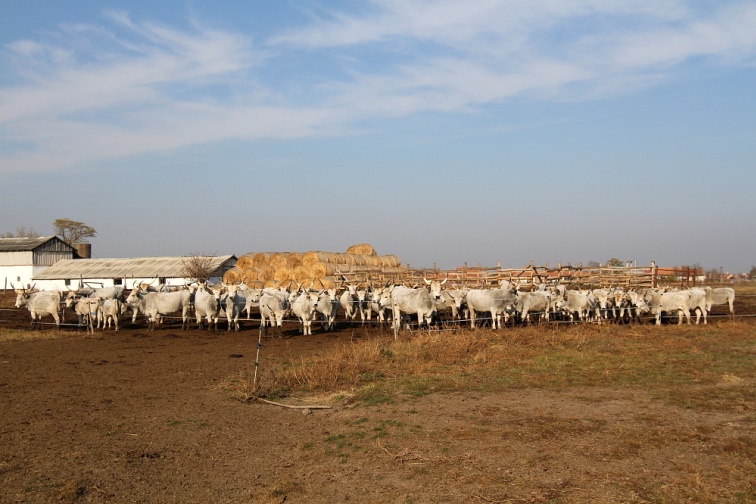
Picture: Hungarian Grey Cattles purchased from the Life+ project (Photo: János Oláh)
In 2012: The intended target of the action - the ecologically sustainable high level of grazing foreseen in the project proposal - has been 100% achieved already in 2011. The desirable high level of grazing was kept throughout 2012 as well.
In April 2012 we have purchased 21 Hungarian Grey Cattle but no other type of livestock was purchased in 2012 (table 5). All livestock was kept according to the EU standard (electric fence or shepherd, winter fodder, veterinary service, registration etc.).
Livestock breeds |
2009 |
2010 |
2011 |
2012 |
Total |
Planned |
Hungarian Grey Cattle |
38 |
1 |
20 |
21 |
80 |
100 |
Mangalica pig |
34 |
0 |
0 |
0 |
34 |
60 |
Horse |
2 |
0 |
0 |
0 |
2 |
10 |
Racka sheep |
109 |
22 |
42 |
0 |
173 |
200 |
Donkey |
4 |
11 |
3 |
0 |
18 |
10 |
Goose |
200 |
200 |
0 |
0 |
400 |
800 |
Total number of grazing livestock at the |
2009 (ind.) |
2010 (ind.) |
2011 (ind.) |
2012 (ind.) |
Cattle |
1070 |
804 |
876 |
819 |
Horse |
16 |
16 |
17 |
12 |
Donkey |
5 |
18 |
23 |
28 |
Mangalica pig |
95 |
75 |
90 |
88 |
Sheep |
1864 |
2180 |
601 |
2105 |
Goose |
200 |
350 |
150 |
0 |
2013: we have already achieved the ecologically sustainable high leveled grazing in 2011. In 2012 and 2013 we maintained this grazing level. Livestock purchase (summarized in table below)
All the livestock funded by the project (see table below) are continuously kept exclusively in the project area.
Table: Number of livestock purchased by the program in 2009–2013
|
Livestock breeds |
Owner |
2009-2013 |
Planned |
Natural Livestock increase (young) |
|
Hungarian Grey Cattle |
HTE |
80 |
100 |
58 |
|
Mangalica pig |
HTE |
34 |
60 |
5 |
|
Horse |
HTE |
2 |
10 |
0 |
|
Racka sheep |
FNB |
110 |
100 |
13 |
|
Racka sheep |
HTE |
173 |
200 |
240 |
|
Donkey |
HTE |
23 |
10 |
5 |
|
Goose |
HTE |
400 |
800 |
0 |
1. Stewardship - involve local farmers to keep some of the project animals
In the spring 2010 FNB commissioned an expert to prepare a study which includes both theoretical and practical items how to encourage local people for animal keeping. Based on this study we also have involved local farmers to keep some of the project animals. Mr Zoltán Koroknai keeps woolly pigs on the Kerek-fenék and the contract allows him to keep the increase. The racka sheep donation scheme has also been launched in 2011 by the associated beneficiary FNB. A total of 110 racka sheep was purchased under the project and leased to local people. The contracts also allow the farmers to keep the increase but the sheep must be grazed at the project site. Four of these farmers were also interviewed and this was published in the ‘The Voices of LIFE – 20 years of getting things done’ publication.
2. Purchase the technical items obligatory for livestock keeping
In April 2009 we purchased the farmhouse in the Nagy-szik (022/4) as foreseen and this farm is the centre of livestock keeping throughout the project period. This farm house has been refurbished, which also included renovation of winter shelters for the Donkeys and Hungarian Grey Cattles.
Mobile (1700 m) and temporary (10 ha has been enclosed) electric fences have been purchased as foreseen. A horse-drawn cart has been purchased on the 08/02/2010.
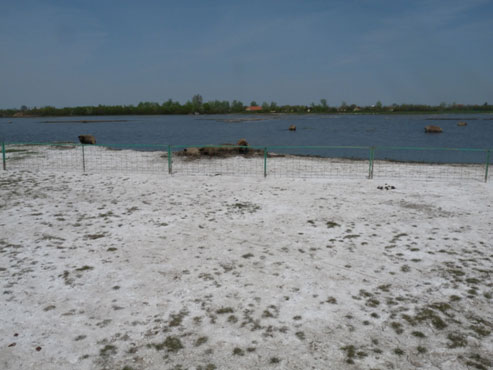
Picture: Temporary electric fence and mangalica pigs in action
3. Ensuring EU standard livestock keeping
Two herdsmen werefull time employed from Balmazújváros to look after the project animals from the beginning of the project period. Also all registration fees, veterinary services, winter fodder and small value consumable material related to the ActionC.4 were serving the livestock keeping. The winter keeping of the increased number of livestock required a rental of tractor (external assistance) as the horse drawn cart was simply not enough to execute the daily work with animals.
4. Coordinating non-project livestock to the project area
Besides the livestock purchased in the frame of project we persuaded other local farmers to keep their livestock in the project site in order to achieve the ecologically sustainable high level of grazing. For example a new herd of Hungarian Grey Cattle (150 individual) was brought to the NW part of Magdolna-puszta because of this coordination work of HEA. This particular area was not utilized for grazing in the past 20 years at all. HEA was also advising to HNPD about the elaboration of the new boarders of land blocks being rented to the local farmers. The sole target was to be able to maximize and maintain the number of grazing animals in the project area in long term.
Lessons learned: (1) These grazing results also gave a fundamental answer to the future management of soda lakes such as the dying (disturbed) soda pans can be changed back to near natural state by using them as a ’grazing lake’. A soda lake has to be self-sustaining even without grazing if it is a healthy ecosystem so the ‘grazing lake’ is a necessary transition stage towards a natural soda lake. (2) The mowing of salt marshy vegetation in the habitat pre-management is better substituted by grazing ‘wooly pigs’. (3) The most suitable livestock to be used for soda pan lakebed and its catchment area management is Hungarian Grey Cattle, Hungarian Flecked Cattle, Donkey and Racka Sheep. They should be kept together in the same habitat or less preferably uses one type of livestock after another but definitely in the same year.

